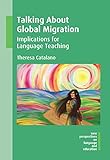Talking About Global Migration : Implications for Language Teaching / Theresa Catalano.
Material type: TextSeries: New Perspectives on Language and EducationPublisher: Bristol ; Blue Ridge Summit : Multilingual Matters, [2016]Copyright date: ©2016Description: 1 online resourceContent type:
TextSeries: New Perspectives on Language and EducationPublisher: Bristol ; Blue Ridge Summit : Multilingual Matters, [2016]Copyright date: ©2016Description: 1 online resourceContent type: - 9781783095544
- 9781783095551
- Emigration and immigration -- Case studies
- Language and languages -- Globalization -- Case studies
- Language and languages -- Study and teaching -- Foreign speakers -- Case studies
- Linguistic minorities -- Study and teaching -- Case studies
- SOCIAL SCIENCE / Emigration & Immigration
- Cultural diversity of student bodies
- Language teacher preparation
- Metaphor
- Metonymy
- Migrants
- Migration crisis
- Migration
- 306.44 23
- P130.5 .C38 2016
- online - DeGruyter
- Issued also in print.
| Item type | Current library | Call number | URL | Status | Notes | Barcode | |
|---|---|---|---|---|---|---|---|
 eBook
eBook
|
Biblioteca "Angelicum" Pont. Univ. S.Tommaso d'Aquino Nuvola online | online - DeGruyter (Browse shelf(Opens below)) | Online access | Not for loan (Accesso limitato) | Accesso per gli utenti autorizzati / Access for authorized users | (dgr)9781783095551 |
Frontmatter -- Contents -- Acknowledgements -- Foreword -- Part 1: Beginnings -- 1. Introduction -- 2. Terminology and Types of Migrants -- 3. What are Metaphor and Metonymy? -- 4. Media Discourse and Migrants -- Part 2: The Stories -- 5. Adventure Migrants -- 6. Refugee/Asylum Seekers -- 7. Family-Reunion/Child Migrants -- 8. Economic Migrants -- 9. Third Culture Kids (TCKs) -- 10. Love and/or Marriage Migrants -- Part 3: The Metaphors and Metonymies -- 11. Summary of Dominant Metaphors/Metonymies in the Stories -- 12. Media Discourse vs. Migrant Discourse -- Part 4: Conclusion and Future Directions -- 13. Conclusion and Future Directions -- Appendix A: Methodology -- Appendix B: Resources for New Migrants -- References -- Index
restricted access online access with authorization star
http://purl.org/coar/access_right/c_16ec
How do migrants describe themselves and their experiences? As the world faces a migration crisis, there is an enhanced need for educational responses to the linguistic and cultural diversity of student bodies, and for consideration of migrant students at all levels of the curriculum. This book explores the stories of over 70 migrants from 41 countries around the world and examines the language they use when talking about their move to a new country and their experiences there. The book interprets common themes from the stories using metaphor and metonymy analysis to lead to more nuanced understandings of migration that have implications for language teachers. The stories also dispel many stereotypes relating to migration, serving as a reminder to us all to consider our own language when talking about this complex subject.
Issued also in print.
Mode of access: Internet via World Wide Web.
In English.
Description based on online resource; title from PDF title page (publisher's Web site, viewed 24. Apr 2022)


